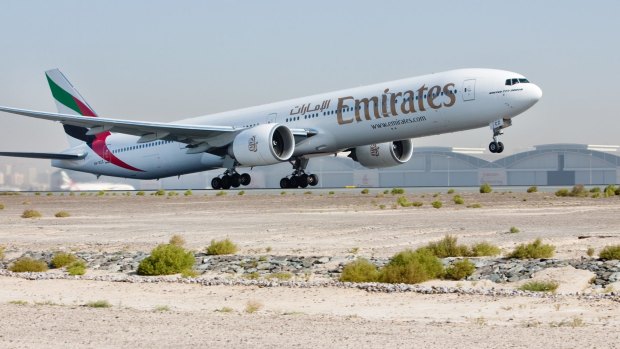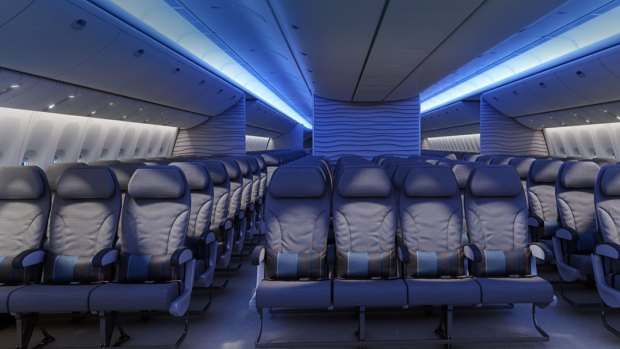This was published 7 years ago
Economy class on Boeing 777s: Airlines increase seats per row from nine to 10
By Lauren Zumbach
Feel like your economy class seat on an overseas flight is a tighter squeeze? You're probably right.
Airlines already have been wedging in more passengers by swapping heavily padded seats for ones with thinner backs or reducing the distance between rows. On wide-body aircraft typically used on international flights and certain long domestic routes, some now are adding an extra seat to each row.
The result: a little less elbow room that may mean battles over armrest turf on your next flight cross-country or abroad.

Emirates is one of the airlines squeezing extra seats into its Boeing 777s.Credit: Ed Turner
When Boeing introduced its wide-body 777 in 1995, most airlines placed orders for aircraft with nine seats across in coach.
But that's changing - international carriers such as Air France, Emirates, Etihad and British Airways all use or say they're moving to 10-seat rows. American Airlines began modifying its existing 777s to fly with 10-seat rows in 2014, though some will keep the roomier nine-across rows with extra legroom in the more expensive Main Cabin Extra section, said spokeswoman Leslie Scott.
The only Australian carrier to use 777s, Virgin, currently has a 3-3-3 layout in its economy cabin.

Airlines are opting for rows of 10 seats, rather than nine, in the Boeing 777.
The 14 new Boeing 777-300s United Airlines expects to receive this year have started arriving with the airline's new lie-flat Polaris business class seat in front and the tighter 10-seat layout in the back. United also is adding the extra seats on 19 of its older 777-200 aircraft that came with a nine-seat configuration, but hasn't said whether it plans to make similar changes to the rest of its 777s.
Most airlines using the Boeing 787 Dreamliner, which can be outfitted with either eight or nine seats per row, also have picked the tighter version, according to Seth Kaplan, managing partner of industry newsletter Airline Weekly.
See also: Airbus A350 vs the Dreamliner: Which new plane is best on a long haul?
Each seat on a Boeing 777 with 10-seat rows is about 17 inches (43cm) wide - roughly an inch less than on a nine-seat version of that plane.
An inch might not sound like much. But passengers can feel the difference, especially on the lengthy flights where they're most likely to encounter a 777, Kaplan said.
"If you're not that tall, you probably care more about width than legroom," Kaplan said.
Adding a seat and taking away those inches can add up - in terms of both passengers and revenue.
On United's older 777-200s, the 19 aircraft with 10-seat rows will carry anywhere from 20 to 98 more passengers than the nine-seat version, depending on the overall layout.
It doesn't cost much to add a few extra passengers to a flight beyond a little extra fuel to carry added weight and potentially an extra flight attendant. The extra revenue to be had from selling a few more airfares is "almost always" greater, United Chief Financial Officer Andrew Levy said at a recent conference.
On average, each United flight this year is taking off with about 5 percent more seats, Levy said. That's primarily because United is swapping small regional jets for bigger aircraft. But about 20 per cent of the growth comes from switching to seats with thinner backs and packing more of those seats on each aircraft, said United spokeswoman Megan McCarthy.
"We're behind in this, quite frankly," Levy said.
Industrywide, the average number of seats on flights departing from the US has grown nearly 17 per cent over the last decade, according to Khalid Usman, vice president at consultant Oliver Wyman.
As at United, most of that comes from a shift away from the smallest regional planes. Aircraft with at most 50 seats accounted for about 24 percent of all flights departing from the US last year, down from 41 percent in 2006, Usman said. But fitting more seats on aircraft has contributed too.
Usman is skeptical that airlines will be as aggressive in rolling out tighter rows as they have been in moving to seats with slimmer backs, which can save inches and weight without further cramping travellers.
"There's a fine line as to how much you can do without irritating customers," Usman said.
Delta Air Lines said it will stick with nine seats on its Boeing 777s, citing customer feedback on the importance of seat comfort on long-haul flights.
The silver lining? After airlines finish rolling out already-announced changes affecting passengers' personal space, there's not a lot of room for more squeezing.
"American, United and Delta do need to give people reasons to fly those rather than Spirit and they know that," Kaplan said. "They're pretty much up against the limits of what they can do."
TNS
See also: Captain of the world's longest flight route reveals his long-haul tips
See also: The best airlines and routes for flying from Australia to the US
Sign up for the Traveller newsletter
The latest travel news, tips and inspiration delivered to your inbox. Sign up now.